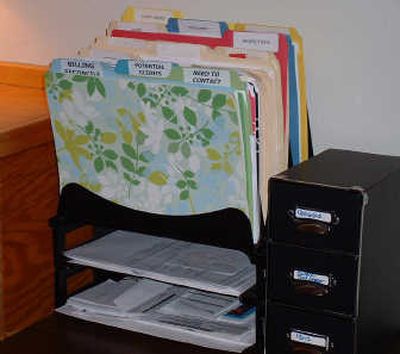Organizer helps you sort life’s clutter

With a mere swivel of her chair, Martha Goss is an arms reach away from all her home-office needs. When a client calls, it takes only seconds to pull their file and see at a glance both billing and call history. And if she needs a new pen or printer paper, she doesn’t even have to get up.
This organizational efficiency is crucial for Goss because her office, which she calls her cockpit, takes up a tiny corner in the tiny guest room tucked under the eaves of her Rathdrum home. But more importantly, she practices the skills she teaches and implements for clients as owner of Organize It, her two-year-old professional organization business.
Most of Goss’s clients are small-business owners, creative right-brain risk takers with a genius for business possibility but little of that left brain logic for the necessary organizational tasks that keep a business running smoothly. That’s where Goss comes in.
After a one-on-one need-based assessment, she provides a plan of action and some tips. For some clients, this is enough to get them on the path of organization. For most, she walks with them through all the steps of sorting and setting up an individualized, maintainable system.
Goss helps clients corral the chaotic details of their lives and businesses, from scheduling tasks into a time management routine to directing the flood of paper that pours in daily.
“Ninety-nine percent need a hands-on relationship,” she says.
Often it comes down to creating a home for both information and things.
“We keep way too much stuff. We keep things just in case,” says Goss. “We are all so ready to save the world. But if that moment does come, we can’t find it.”
With a degree in business management and marketing and experience working in offices in a variety of industries across the country, Goss has developed a sense for organizational principles that work for both business and home. But it starts by separating the two. Even in a home office doubling as a bedroom, Goss keeps business files separate from personal files and everything so clearly labeled, her 10-year-old son can do her filing and her husband can quickly find last year’s tax records or the cord to the camera.
To get to this level of organization, she recommends first stopping to take inventory of what you have and making sure the things worth keeping have a home, whether treasured mementos or financial documents.
“People don’t want to let go of the past, but they are not giving it any respect,” says Goss of how people tend to accumulate and store their lives. She admits she isn’t above that tendency herself, but without a lot of square footage, she regularly evaluates what she is keeping, why she is keeping it and where it should belong.
She compares this process to sorting fruit. Rather than having a big bin with apples and oranges and bananas all jumbled together, you pick out the 10 best apples, putting them together and toss the rotten ones.
By evaluating, sorting, purging, categorizing and finally, creating a home for whatever is left over, the end result is an ability to find what you need, when you need it, with the accompanying freedom to focus on what’s important both professionally and personally.
For Goss, when a client calls, it is important that she immediately know what their needs are, what she has already done to help them, and their account status. That’s why she keeps action files, like client files and often-used forms, in a table-top sorter just a chair swivel away.